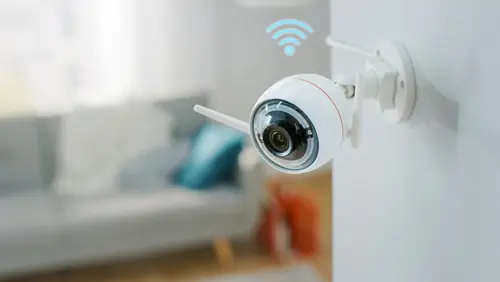Wireless camera antennas are a vital component for many photographers who rely on wireless technology for their work. Whether you’re a professional or amateur photographer, having a reliable wireless camera antenna is essential to ensure that you have a stable and consistent signal when capturing images.
There are various types of wireless camera antennas available in the market today, and choosing the right one can be overwhelming, especially for beginners. This article aims to provide an in-depth guide to help photographers understand the different types of wireless camera antennas, their compatibility with various camera models and brands, indoor vs. outdoor use, range, and signal strength.
We will also discuss the factors that photographers should consider when choosing a wireless camera antenna. By the end of this article, photographers will have a better understanding of the importance of wireless camera antennas, and be equipped with the knowledge to make an informed decision when purchasing one.
Key Takeaways
- There are two primary types of wireless camera antennas: directional and omnidirectional.
- Antenna placement is crucial for optimal performance and signal quality.
- Compatibility with camera models/brands is important for effective signal transmission.
- Range and signal strength are important factors to consider, along with potential interference from other wireless devices, physical obstacles, and weather conditions.
Types of Wireless Camera Antennas
The categorization of wireless camera antennas into distinct types is crucial for photographers seeking to optimize their wireless connectivity and attain superior image quality. Two primary types of wireless camera antennas are directional and omnidirectional.
Directional antennas focus their signal in a specific direction, making them ideal for long-distance transmissions and reducing interference from other signals. On the other hand, omnidirectional antennas radiate signals in all directions, providing a broader coverage area, making them ideal for short-range transmissions in confined spaces or where the direction of transmission is uncertain.
Antenna placement is equally important, as the wrong placement can result in poor signal quality and signal loss. It’s essential to position the antenna as high as possible and avoid obstacles that can obstruct the signal path. Careful consideration of the type of antenna and placement can have a significant impact on the quality of wireless connectivity, which can make a big difference when it comes to capturing stunning photographs.
Compatibility with Camera Models and Brands
Compatibility between antennas and camera models and brands is crucial for effective signal transmission, just like how a key must fit perfectly into a lock to unlock the door. When choosing a wireless camera antenna, it is important to ensure that it is compatible with your camera’s make and model to avoid any issues during the installation process.
Different camera manufacturers use different antenna materials and designs, which can affect the signal strength and range of the wireless camera system. Therefore, it is important to research and choose an antenna that matches your camera’s specifications to ensure optimal performance.
Additionally, some camera models may require a specific type of antenna or adapter, so it is important to check the manufacturer’s recommendations before making a purchase. By taking the time to ensure compatibility between your camera and antenna, you can avoid potential signal loss or weak connectivity issues and ensure a smooth wireless camera experience.
Indoor vs. Outdoor Use
When considering the use of antennas for signal transmission, it is important to distinguish between indoor and outdoor environments, as the physical surroundings can significantly affect the range and quality of the signal.
When using wireless cameras indoors, the signal is less likely to encounter interference factors such as walls, ceilings, or other obstacles that might obstruct or weaken the signal. However, the range of the signal may still be limited due to the presence of competing wireless networks or electronic devices that can interfere with the signal.
On the other hand, outdoor use presents additional challenges and installation options, as the signal must penetrate through external obstacles such as trees, buildings, and other natural elements. The type of antenna required will depend on the distance and quality of the signal required, as well as the level of interference present.
It is important to carefully consider the specific needs and requirements for both indoor and outdoor use when selecting a wireless camera antenna, in order to ensure optimal performance and quality of the signal transmission.
Range and Signal Strength
Understanding the range and signal strength of an antenna is crucial for ensuring optimal performance and quality of signal transmission. As a photographer, it is important to consider the location of the antenna placement and any potential interference issues that may arise.
The range of an antenna refers to the maximum distance it can transmit a signal without any significant loss in quality. It is important to note that the range of an antenna can be affected by environmental factors such as obstacles, terrain, and weather conditions.
Signal strength, on the other hand, refers to the power of the signal being transmitted by the antenna. A stronger signal can help to overcome interference issues and provide a clearer and more stable connection.
When purchasing a wireless camera antenna, it is important to consider both the range and signal strength to ensure that it is suitable for your specific needs and location.
Factors to Consider When Choosing a Wireless Camera Antenna
One crucial aspect to consider when selecting an appropriate antenna for signal transmission is the potential sources of interference. Interference can come from a variety of sources, including other wireless devices, physical obstacles, and weather conditions. It is important to choose an antenna with a high gain to help cope with these sources of interference.
Additionally, installation tips and maintenance requirements should be taken into account when selecting an antenna. The antenna should be easy to install and maintain to minimize downtime and avoid additional costs.
It is also important to choose an antenna that is compatible with the camera system being used to ensure optimal performance.
Overall, selecting the right antenna requires careful consideration of these factors to ensure reliable and steady signal transmission.
Conclusion
Wireless camera antennas are an essential tool for photographers who require a reliable and stable connection between their cameras and other devices. There are different types of antennas with varying compatibility with camera models and brands. Knowing the right type of antenna to use for your camera is crucial to achieving excellent image quality and avoiding connection issues.
When purchasing a wireless camera antenna, it is important to consider whether it is designed for indoor or outdoor use. Outdoor antennas are usually more durable and weather-resistant, while indoor antennas are designed to work in a controlled environment. Additionally, the range and signal strength of the antenna are essential considerations. A high signal strength antenna offers a more stable and reliable connection, while a long-range antenna can capture images from a distance.
When choosing a wireless camera antenna, several factors must be considered, including the frequency range, antenna gain, and polarization. These factors will affect the antenna’s performance, range, and overall signal quality. It is also essential to ensure that the antenna’s connector type matches your camera’s connector type to avoid compatibility issues.
In conclusion, wireless camera antennas are critical tools for photographers who require a stable and reliable connection between their cameras and other devices. Choosing the right antenna is essential for achieving excellent image quality and avoiding connection issues. Factors such as compatibility, range and signal strength, and indoor or outdoor use should be considered when purchasing a wireless camera antenna. Ultimately, investing in a high-quality antenna will ensure a seamless and hassle-free experience for photographers.
You may also like to read:
How Can Photos Help You Improve Your Home Addition Ideas?

